Hugelkultur is a method of making a garden bed using waste wood and available nitrogen, that preserves those nutrients and gives them up to growing plants over several seasons. Like compost, a hugelkultur bed or hugel bed makes use of carbon and nitrogen to decompose and create humus, while generating both heat and moisture.
Hugelkultur beds:
- Heat up faster in the spring
- Retain moisture
- Need no additional fertilizer
- Need less irrigation
- Produce more food in less space
- Are an efficient use of resources
- Are easier to weed
- Are great for perennial crops
- Are rich in nitrogen
- May need supplemental minerals or kelp fertilizer to balance
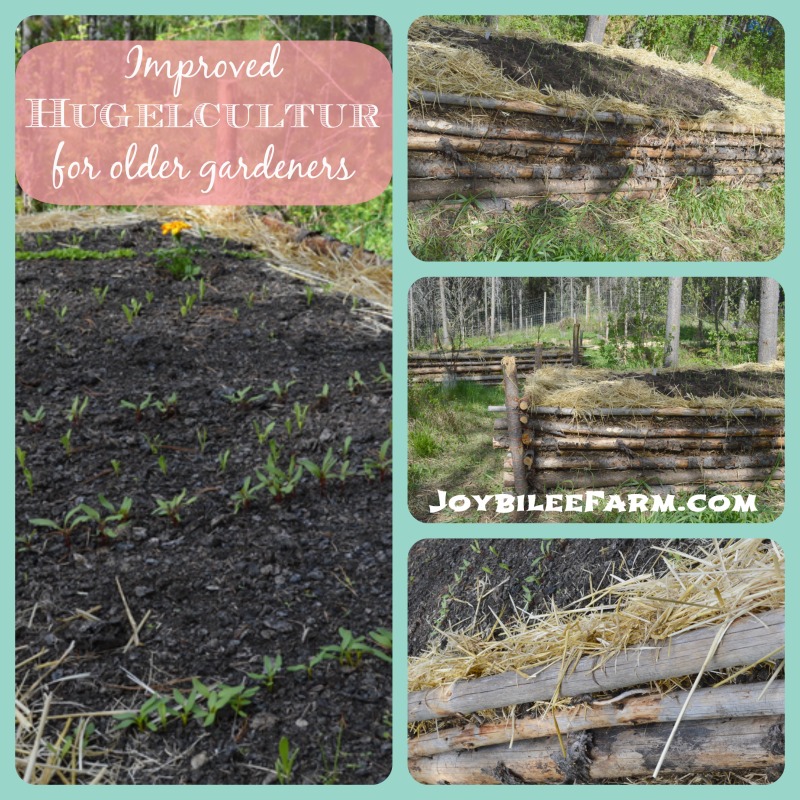
Two years ago we built a hugelkultur bed in our forest garden using waste wood, straw, animal manure, and finished compost. The bed had some difficulties.
Year one:
I planted carrots and beets in the hugel bed the first year. The root vegetables air-pruned when the long roots went through the compost on the top of the bed and hit the area below where the waste wood was. That meant, that while the carrots did grow, we didn’t get much of a harvest. But it was a good learning experience.
Year two:
My chickens got through the fence in the second year and scratched out quite a bit of the surface compost from the top of the bed. We replenished the finished compost and built the bed back up the second spring, and planted strawberries. The bed was easy to weed. The strawberries did well. Near the end of the season the strawberry leaves turned pale with pronounced green veins – chlorosis. This is corrected with the addition of a magnesium solution, which increases the bioavailability of some trace minerals in the soil.
Year 3:
The hugel bed shrunk in height in the third year, as more of the waste wood rotted beneath. The bed was quicker to heat up in the spring and retained its moisture, not needing to be watered when the rest of the garden was. The leaves are again showing signs of chlorosis and will need to be treated with magnesium sulphate to increase the bioavailablity of trace minerals.
What I wanted changed:
Over all, I wanted the hugel bed to be higher so that, as I get older, I can garden with less bending and squatting. The hugel bed can be made as high as the available waste wood. Our farm helper built two new hugel beds this year and built up the walls with logs so that the beds are high enough that I can garden standing up. I love it. They were so easy to plant and will be easy to weed as well. The beds were finished two weeks ago and after the first rain, they started to warm up significantly. Both are already planted. Seed germination was quick and thorough.
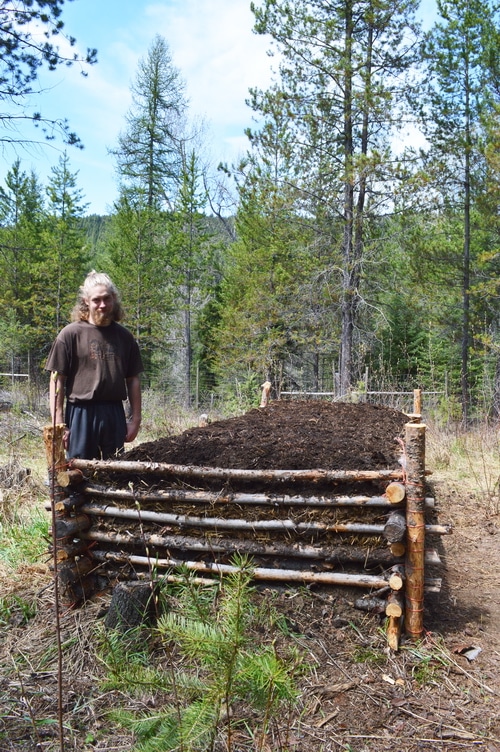
Nathan, our farm helper, built the sides up with waste wood, and threw the stumps and branches in the middle of the bed, to provide the foundation.
Since we raise llamas there were several llama dung piles around the barn yard, and Nathan cleaned those up and dumped the dung over the logs to fill up the spaces. Two jobs with one action – economy of time. This was topped with about a foot of 1 year old composted manure – still clumpy with lots of hay and straw in it. The final layer was a foot of finished compost ready to plant. I pushed straw around the perimeter of the top of the bed to catch any irrigation run off and keep it in the bed. Once the seeds are 6 inches high, and it warms up here, I’ll mulch the bed with straw to prevent the surface from drying out.
What I like about the new design:
- It’s taller
- It is neater in appearance
- The sides won’t cave in as the bed decomposes
- I can garden standing up
- It’s deeper and therefore has more mass to retain heat and moisture
- It’s less fatiguing to plant standing up than to plant bending over
- The plants in the hugel bed are growing more quickly than the plants I put in the ground at the same time.
- Soil moisture can be made more efficient by digging a trench around the bed to catch run-off and direct it back to the bed.
- The raised bed is easier to cover with row covers to extend the season.
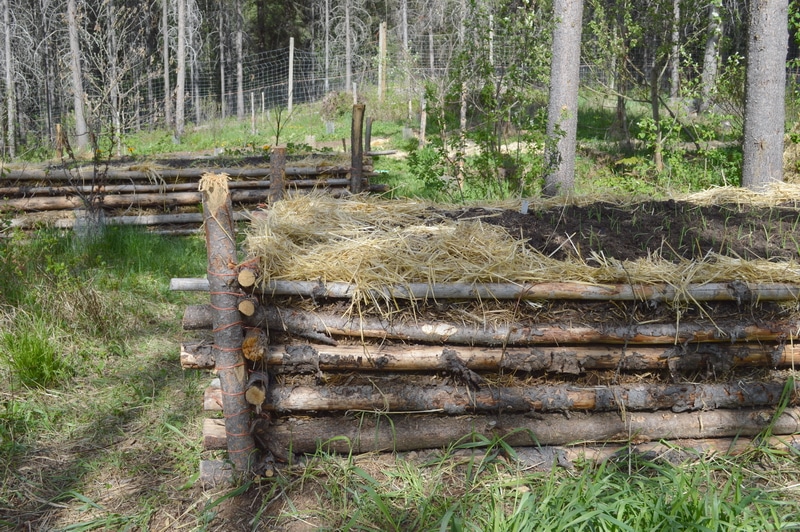
Some drawbacks:
I noticed that some of the waste wood had ants and I will have to discourage them from using the hugel bed as a home
There are places for mice, voles, and wasps to house within the walls of the hugel bed, so I’ll need to watch for this, and take steps to discourage it.
The bed will sink as the waste wood decomposes and more compost will have to be added periodically. This is not really a draw back as I have lots of manure and composted manure on the farm and this makes good use of it.
I’ll avoid growing plants with long tap roots, like carrots, beets, and kale until the bed has been established for several seasons.
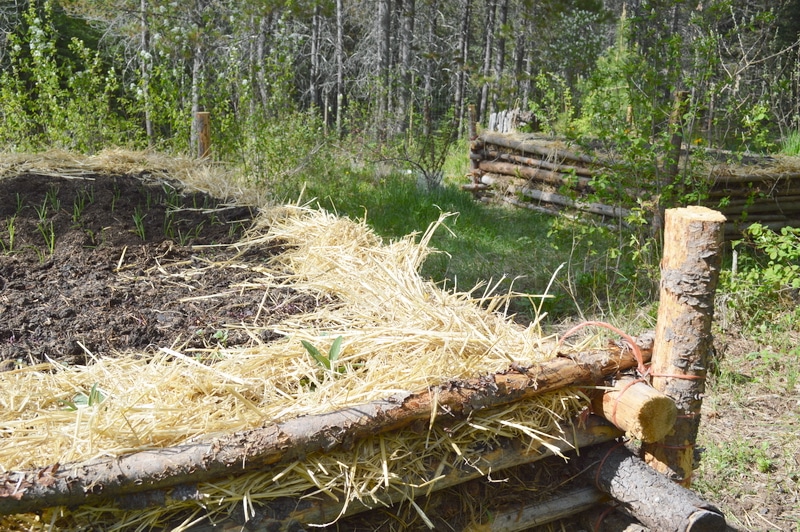

The hugel bed is a permaculture technique to increase the efficiency of biowaste products and grow more food. I think it’s a really good technology. There are as many forms of hugelkultur as there are gardeners. I suggest that you take the good points that work for you, and as I did, fine tune them to your own situation and the available biomass that you have to work with.
As the bed decomposes and shrinks, you’ll want to add more compost to the surface to keep it high. Larger hugelbeds made with the help of a tractor and utilizing whole trees, won’t need as much attention as smaller, human size beds.
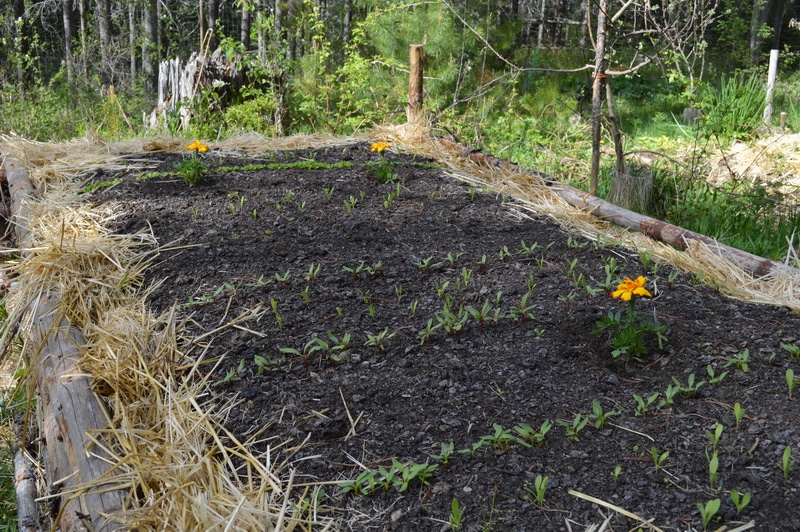
If you have a source of manure and waste wood, give hugelkultur beds a trial run on your homestead. But don’t settle for the low beds. Instead build up the bio-mass and extend the height and make a hugelkultur bed that will be kind to you in your senior years.



I live in East Texas and understand your pain about red ants.. all ants. Even though all my research says ants are mostly beneficial in a garden. I feel like they haven’t dealt with feet covered and stung! I try avoid pesticides as well. After trying several methods, I found water works best. I put my sprayer on “jet” and drown them out. It may take a couple of days, but they eventually move on. Do keep an eye out for them just moving to a new area of the garden. You may have to follow the colony around for a bit before they get the hint and move completely off your radar. Hope this helps!!
You are thorough in your article. It is easy to understand. We have 12 acres of woods so we have almost an unending supply of wood and branches for Hugelcultur. We live in zone 4 but usually plant perennials for zone 3 because winters are so variable.
Last year my husband made 4 elevated garden beds. He made a wood frame with the sides and ends
made of metal roofing that someone gave us. They are about 20″ high. He filled it like your beds.
The top board is sideways so I sit on it to plant, weed (have very little), and water. It ‘s so easy. We grew Swiss chard, tomatoes, radishes, beets and carrots in these beds. All did fantastic except carrots. In early Autumn we transplanted rhubarb into an elevated bed. Some are up 6″. He’s making at least 3 more elevated beds this year when he can. I’m 69 and have some physical limitations. These beds make my garden work so much easier.
Hi, VR, we live in zone 3. Our ground is cool year round and we only have about 70 days frost free, most years. I use my hugelkultur beds for perennial herbs, and for greens mostly. I plant bok choy, tsatsoi ,and other quick to grow spring greens in them at the end of April. Along with a blend of mixed lettuces, planted close together for a cut and come again spring mix. I cover these after planting with a thin sheet of landscape cloth to keep the heat in, in the early spring.
I also use these beds for radishes, chard, and perennial herbs like bee balm, oregano, and lemon balm. I do have to amend the beds each spring with additional compost. The soil tends to sift down as the wood inside the bed decomposes, so I need to top it up just once, early in the season. All these plants can handle dappled shade. Kale and broccoli, cabbage, have deeper roots and for me they do better when planted in the ground or in an ordinary raised bed. The hugelkultur soil seems too shallow for these deep rooted plants to do well. I have planted zucchini and it does do well in these beds, but other squashes don’t get the warmth they need in my climate, in these raised beds.
Beware if you live where poisonous snakes live, the open sides of this kind of hugelkultur bed will harbour snakes. We only have garter snakes where we live and they do keep the orchard mice population down, so for me it’s an advantage, but if I lived where there were poisonous snakes I’d bury the hugelkultur bed in the ground and make a mound rather than building up with wooden sides like I have done.
The last comments on this post are over a year old, but I hope you are still responding to comments.
First, your descriptions and instructions are excellent; thank you for sharing all this information.
Second, we live in a wooded area, somewhat similar to your photos. There’s dappled sunlight, but not intense sun that most vegetables need.
Could you advise on what you grow in the three seasons (spring, summer, fall)?
Do you have a bed for each season?
Any suggestions that you can provide about the types of plants, annuals/perennials, one can grow in a partly shady hugelkultur bed will be helpful.
Thank you.
Great post. Quick question. I live in South Carolina and fire ants are a nemesis. How can I get rid of or at least control the ants? Anything that they can pile up on, they will. Don’t use any pesticides at my house as cancer runs in my family. Thanks bunches. Love your site.